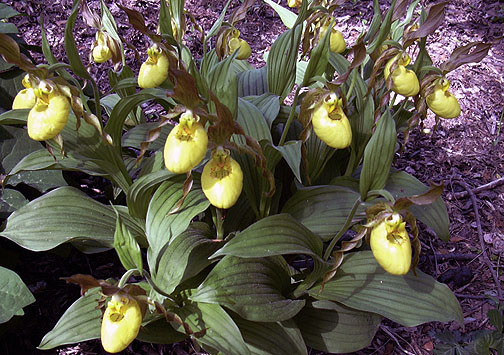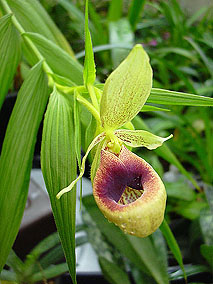

|
Over the last 50 years, we have learned how to cultivate and propagate orchids of the genus Cypripedium. Today, these beautiful plants are increasingly available, both as species and as hybrids. These examples are grown in my home and garden in Baltimore, Maryland, USA. We are located on the boundary of USDA plant hardiness zones 6 and 7. Please note -- I don't sell Cypripediums except an occasional few extras at talks. But, check here for a listing of sources of propagated Cypripedium and Selenipedium plants along with flasking services and growing supplies.
So why the slipper? How does it work? Click here for more about the Cypripedium slipper! |

Cypripedium pubescens 'Vigrous' |
Cypripedium pubescens was the first orchid species I attempted in 1957. The poor plant -- undoubtably collected -- perished in a hot west window of our family's apartment, but not before blooming and permanently hooking me on the orchid-growing hobby.
The species has since proven most adaptable to cultivation. Beginning with three growths in 1986, my plants have multiplied to over fifty. Nearly 30% of plants carry two blossums. |
|
Cypripedium japonicum has proven well suited to the Baltimore climate. It blooms reliably. The clone I have has not multiplied yet, probably because I am setting seed on it, but has grown in size and vigor each year.
For more on Cypripedium japonicum, click here. |

Cypripedium japonicum 'Sweet Lips' |

Cypripedium Aki 'Hot Summers' (pubescens x macranthos) |
About half of my plants are hybrids. Many are quite lovely, inheriting the best of both parents. Cypripedium Aki inherits the vigor and heat tolerance of the pubescens parent and the color of macranthos. Note that macranthos appears to wipe out the yellow color in its hybrids in much the same way as Paphiopedilum delenatii.
In the sunny beds outdoors, I have pubescens, parviflorum, makesin, kentuckiense, japonicum, henryi, tibeticum, Rascal, Ulla Silkens, and Philippe. I would have expected tibeticum to resent our Baltimore summers, but it and the one tibeticum hybrid seem to take them in stride. After over 40 years of observation, I am increasingly convinced of the wisdom of classifying pubescens as a separate species as the RHS has done. Its behavior is distinct and consistent both as a species and in its hybrids. |
|
Cypripedium seedlings approaching blooming size out of the home refrigerator. The older seedlings have prospered through 3 winters in the refrigerator and 3 Baltimore summers outdoors, including periods of over a week with temperatures above 100° F. The first blooms generally occur three years out of flask.
I find the following are growing well in Baltimore from seedlings: Hank Small (upperleft in blooom), calceolus, parviflorum, Ventricosum, Rascal, Chauncey, Michael, Andrewsii (lower-right in bloom), Philippe, macranthos (from Dahlnegorsk), and calceolus x tibeticum. Note that Andrewsii is the name given to the remake of the wild Cypripedium xandrewsii registered with the Royal Horticultural Society. |

Cypripedium seedlings approaching blooming size. |

Selenipedium aequinoctiale |
Selenipedium Observations |
|
Permission is granted to reproduce these pages for educational use in newsletters and programs.
|